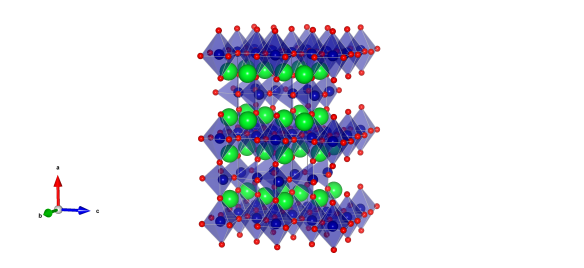Organize your oxygen with brownmillerite, SrCoO2.5
What does it look like?

Image generated by the VESTA (Visualisation for Electronic and STructual analysis) software http://jp-minerals.org/vesta/en/
In the SrCoO2.5 structure shown above the green are strontium atoms, the blue atoms are cobalt atoms, and the red are oxygen atoms.
What is it?
Not too long ago, you were introduced to the extremely versatile perovskite structure. In addition to being a widely observed crystal structure itself, the perovskite form can be found as a “building block” in many other types of structures. Today's crystal structure, brownmillerite, has perovskite layers that alternate with layers of oxygen tetrahedra that center on the B atom (here Co), forming a superstructure.
Brownmillerite SrCoO2.5 is particularly interesting because of how it forms. SrCoO3 has a classic perovskite material. But cool things happen when you start creating oxygen vacancies within the system. Rather than have the vacancies spread randomly throughout the crystal, which occurs in most materials, they create a new order! (For your fancy vocabulary word of the day – this is called a topotactic phase transformation.) This is the origin of the oxygen tetrahedra, which are made of two fewer oxygen then the octahedral in the perovskite layers. The difference in structure between perovskite SrCoO3 and brownmillerite SrCoO3 has been known for a while, but recent work has shown that the phase transition between the two can be engineered through temperature and environment (see Jeen et al. in Advanced Materials or Nature Materials).
Where did this structure come from?
While the electrical and magnetic properties of oxygen deficient SrCoOx materials were first thoroughly studied by Hiroshi Wantanabe in 1957 the first structural study on the brownmillerite SrCoO2.5 was reported by Wantanabe, Takayoshi Takeda, and Yasuo Yamaguchi in 1972.






